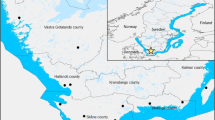Abstract
Pseudothecia of Pleospora allii developed best on garlic leaf debris infected by Stemphylium vesicarium incubated at low temperature (5–10°C) and relative humidity (RH) close to saturation. RH of less than 96% prevented the formation of pseudothecia, while an incubation temperature of 15–20°C led to the early degeneration of pseudothecia. Under natural conditions, colonization by pseudothecia of unburied garlic leaf debris varied between seasons from 6.0 to 15.5 pseudothecia/mm2, whereas lower colonization levels were recorded when samples were buried. Pseudothecial maturity was reached 1–4 mo after the deposition of garlic debris on the soil surface and 15 days after the burial of residues. In the later case, pseudothecia degenerated with degradation of the plant debris. Ascospore release, which required rainfall or dew periods, occurred between late January and late April depending upon the year. A high correlation was found between pseudothecia maturation and four meteorological variables. Two of which, i.e. the number of hours with RH≥98% and with a mean temperature of 4.5–10.5°C, and the accumulated rainfall, explained most variability (adjusted R2=0.82−0.98 depending upon the year). A multiple regression equation relating the pseudothecia maturity index with these two variables could be used to forecast the epidemic onset of Stemphylium leaf spots in Southern Spain. Temporal progress of pseudothecia maturation was best fitted by a monomolecular model.
Similar content being viewed by others
References
Aveling TAS and Naude SP (1992) First report of Stemphylium vesicariumon garlic in South Africa. Plant Disease 76: 426
Basallote MJ, Prados AM, Pérez de Algaba A and Melero JM (1993) First report in Spain of two leaf spots of garlic caused by Stemphylium vesicarium. Plant Disease 77: 952
Basallote MJ, Centeno E, Melero JM, Pérez de Algaba A and Prados AM (1996) Manchas foliares ocasionadas por Stemphylium vesicariumen el cultivo del ajo. Phytoma España 76: 26-29
Conway KE (1987) Purple spot (Pleospora herbarum) of asparagus in Oklahoma. Plant Disease: 376
Dhingra OD and Sinclair JB (1985) Basic Plant Pathology Methods. CRC Press, Florida
Evans TA and Stephens CT (1984) First report in Michigan of the teleomorph of Stemphylium vesicarium, causal agent of purple spot of asparagus. Plant Disease 68: 1099
Falloon PG, Falloon LM and Grogan RG (1984) Purple spot and Stemphyliumleaf spot of asparagus. Calif., Agric. 38: 21
Falloon PG, Falloon LM and Grogan RG(1987) Etiology and epidemiology of Stemphyliumleaf spot and purple spot of asparagus in California. Phytopathology 77: 407-413
James JR and Sutton TB (1982) Environmental factors influencing pseudothecial development and ascospore maturation of Venturia inaequalis.Phytopathology 72: 1073-1080
Johnson DA (1990) Effect of crop debris management on severity of Stemphyliumpurple spot of asparagus. Plant Disease 74: 413-415
Leach CM (1971) Regulation of perithecium development and maturation in Pleospora herbarumby light and temperature. British Mycological Society Transactions 51: 295-315.
Luttrell ES (1981) The pyrenomycete centrum-Loculoascomycetes. In: Reynolds DR (ed.) Ascomycete systematics (pp 124-137) Springer Verlag, New York
Müller E (1979) Factors inducing asexual and sexual sporulation in fungi (mainly Ascomycetes). In: Kendrick B (ed.) The Whole fungus (pp 265-282) National Museum of Natural Sciences, Ottawa
Navas-Cortés JA, Trapero-Casas A and Jiménez-DíazRM(1995) Survival of Didymella rabieiin chickpea straw debris in Spain Plant Pathology 44: 332-339
Prados AM, Melero JM and Basallote MJ (1994) Development of the teleomorph of Stemphylium vesicariumin garlic debris affected by leaf spots. Proceedings of the 9th Congress Mediterranean Phytopathological Union (pp 159-161), September 1994, Kusadasi-Aydin, Türkiye
Rao NN and Pavgi MS (1975) Stemphyliumleaf blight of onion. Mycopathologia 56: 113-118
Ross GJS (1982) Maximum likelihood program. Rothamsted Exp. Stn. Harpenden, UK
Shishkoff N and Lorbeer JW (1989) Etiology of Stemphyliumleaf blight of onion. Phytopathology 79: 301-304
Simmons EG (1969) Perfect states of Stemphylium.Mycology 61: 1-26
Trapero-Casas A and Kaiser WJ (1992) Development of Didymella rabiei,the teleomorph of Ascochyta rabiei, on chickpea straw. Phytopathology 82: 1261-1266
Trapero-Casas A, Navas-Cortés JA and Jiménez-DíazRM(1996) Airborne ascospores of Didymella rabieias a major primary inoculum for Ascochytablight epidemics in chickpea crops in southern Spain. European Journal of Plant Pathology 102: 237-245
Zentmyer GA and Bald JG (1977) Management of the environment. In: Horsfall JG and Cowling EB (eds.) Plant Disease an advanced treatise. Vol. I. (pp 122-140) Academic Press, Inc, New York
Author information
Authors and Affiliations
Rights and permissions
About this article
Cite this article
Prados-Ligero, A., González-Andújar, J., Melero-Vara, J. et al. Development of Pleospora allii on Garlic Debris Infected by Stemphylium vesicarium. European Journal of Plant Pathology 104, 861–870 (1998). https://doi.org/10.1023/A:1008619604684
Issue Date:
DOI: https://doi.org/10.1023/A:1008619604684




